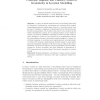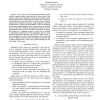72 search results - page 11 / 15 » Qualitative Spatial Representation and Reasoning Techniques |
IJCAI
2007
13 years 10 months ago
2007
Most existing sketch understanding systems require a closed domain to achieve recognition. This paper describes an incremental learning technique for opendomain recognition. Our s...
KI
2010
Springer
13 years 7 months ago
2010
Springer
Location models are data structures or knowledge bases used in Ubiquitous Computing for representing and reasoning about spatial relationships between so-called smart objects, i.e....
ER
2010
Springer
13 years 7 months ago
2010
Springer
Abstract. We demonstrate the manner in which high-level design requirements, e.g., as they correspond to the commonsensical conceptualisation of expert designers, may be formally s...
GIS
2005
ACM
14 years 10 months ago
2005
ACM
Information about dynamic spatial fields, such as temperature, windspeed, or the concentration of gas pollutant in the air, is important for many environmental applications. At th...
ROMAN
2007
IEEE
14 years 3 months ago
2007
IEEE
— For a robot to be able to first understand and then achieve a human’s goals, it must be able to reason about a) the context of the current situation (with respect to which i...


